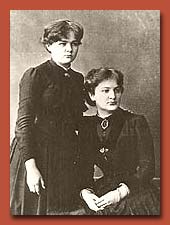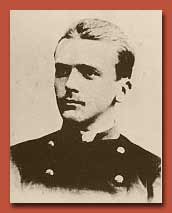 |
| The close relationship between Manya and her
sister Bronya, shown here in 1886, continued throughout their
lives. (Photo ACJC) |
READ
Curie's words
|

 The Governess
The Governess
 ARIA
AND BRONYA MADE A PACT: the younger sister, still not
17, would work as a private tutor, setting aside money to pay Bronya's
tuition at medical school in Paris and her living expenses there.
As soon as Bronya could, she would help subsidize Maria's education. ARIA
AND BRONYA MADE A PACT: the younger sister, still not
17, would work as a private tutor, setting aside money to pay Bronya's
tuition at medical school in Paris and her living expenses there.
As soon as Bronya could, she would help subsidize Maria's education.
After two years of
teaching various subjects to children from wealthy families, Maria
realized she was not saving money efficiently enough. For the next
three years she worked as a well-paid governess.
|
| Her charges were the
children of an agriculturist who ran a beet-sugar factory in a village
150 kilometers north of Warsaw. Maria felt a kinship with her employer
when he permitted her in her spare time to teach the illiterate children
of his peasant laborers. He encouraged his older daughter to assist
Maria, even though he knew the czarist authorities equated such activity
with treason. “Even this innocent work presented danger,”
Maria recalled, as all initiative of this kind was forbidden by the
government and might bring imprisonment or deportation to Siberia.
|
| When their
governess fell in love with their oldest son, however, her employers
were none too pleased. As fond as they were of Maria, they did not
welcome the knowledge that their beloved Kazmierz, on vacation from
his agricultural engineering course in Warsaw, wanted to marry the
penniless girl. Although the couple bowed to his parents' wishes and
broke off the engagement, their romantic involvement continued for
several years more. As difficult as it was to stay under the same
roof as a family that clearly did not welcome her as one of their
own, Maria remained in their employ because she took her pact with
Bronya seriously. |

|
| Marie's continuing romantic interest in Kazmierz
Zorawski, whom she met while serving as governess to his younger
siblings, helped hold her back from joining Bronya in Paris.
(Photo ACJC) |
|
“If
[men] don't want to marry impecunious young girls, let them
go to the devil! Nobody is asking them anything. But why do
they offend by troubling the peace of an innocent creature?”
--letter of Marie Curie to her cousin Henrietta Michalowska,
April 4, 1887
|
 O
FILL HER LONELY HOURS she began a course of self-study. Unsure
at first where her academic interests lay, she read sociological studies
and works of literature along with physics and chemistry textbooks.
By mail she also took the equivalent of an advanced math course with
her father. When it became clear that math and the physical sciences
were her forte, she took chemistry lessons from a chemist in the beet-sugar
factory. O
FILL HER LONELY HOURS she began a course of self-study. Unsure
at first where her academic interests lay, she read sociological studies
and works of literature along with physics and chemistry textbooks.
By mail she also took the equivalent of an advanced math course with
her father. When it became clear that math and the physical sciences
were her forte, she took chemistry lessons from a chemist in the beet-sugar
factory. |
|
 |
Professor
Sklowdowski in Warsaw in 1890, with his daughters Maria (extreme
left), Hela, (far right), and Bronya, who was on a visit home
from medical studies in Paris. (Photo ACJC)
READ Curie's words |
|
After
returning to Warsaw in 1889, Maria worked as a live-in governess for
another year before resuming life with her father and work as a private
tutor. During her absence Sklodowski had become director of a reform
school, and the new position paid well enough for him to send a monthly
subsidy to Bronya in Paris. By arrangement with Bronya, he began to
set aside a portion of that subsidy to compensate Maria for the sums
she had been sending her sister. Eventually it became clear that by
fall 1891, Maria would have enough money to begin studies at the University
of Paris--the famous Sorbonne. |
“During these years of isolated
work, trying little by little to find my real preferences,
I finally turned towards mathematics and physics, and resolutely
undertook a serious preparation for future work.”
|
 ARIA
STILL LACKED real laboratory experience, and she hoped to gain
some before her departure. This was no easy task, given the czarist
ban on such work. The ingenuity of her cousin Joseph Boguski helped
her achieve her illicit goal. A former assistant of Russian chemist
Dmitri Mendeleev , Boguski ran the so-called
Museum of Industry and Agriculture, which was actually a laboratory
aimed at training Polish scientists. One of Boguski's colleagues there
gave Maria an intensive chemistry course on Sundays and evenings.
More often than not, however, she struggled through experiments on
her own, often failing to duplicate the expected results. ARIA
STILL LACKED real laboratory experience, and she hoped to gain
some before her departure. This was no easy task, given the czarist
ban on such work. The ingenuity of her cousin Joseph Boguski helped
her achieve her illicit goal. A former assistant of Russian chemist
Dmitri Mendeleev , Boguski ran the so-called
Museum of Industry and Agriculture, which was actually a laboratory
aimed at training Polish scientists. One of Boguski's colleagues there
gave Maria an intensive chemistry course on Sundays and evenings.
More often than not, however, she struggled through experiments on
her own, often failing to duplicate the expected results.
 |
| These buildings in the old town of Warsaw
(destroyed in World War II and rebuilt) show the high level
of beauty and civilization that helped inspire Polish patriots. |
Finally, in autumn
1891, Maria Sklodowska set out for Paris. Traveling as economically
as possible, she carried not only enough food and reading for the
trip but also a folding chair and a blanket: fourth-class travelers
through Germany were not provided with seating. “So it was
in November, 1891,” she recalled, “at the age of 24, that
I was able to realize the dream that had been constantly in my mind
for several years.”
� 2000 -
American Institute of Physics
|
|

